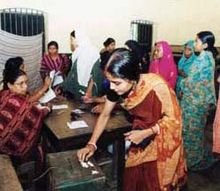User:Kiaana.pr/Women's Participation in Bangladesh Politics
Women's participation in Bangladesh Politics
[edit]
Women's participation in political decision-making is critical for both achieving gender equity and promoting development[1]. However, Bangladeshi women face a double marginalization: they hold a subordinate position in all aspects of life, and even within the political sphere, their influence is minimal[2]. Understanding this marginalization requires examining the extent of women's and men's participation across various institutions. Traditional societal divisions between public and private spheres significantly restrict women's involvement in political processes[3]. Consequently, few Bangladeshi women hold leadership positions in central and local governments, or even within administrative structures. This lack of access to decision-making positions translates to minimal impact on policy development, management, and implementation[4]. Increasing women's role in decision-making is therefore crucial for their empowerment and for achieving broader societal progress[1].
Overview of Women's Participation in Politics
[edit]
A significant step towards women's public inclusion came with the 1976 Union Parishad Ordinance, reserving two seats for women in each local council[5]. This quota subsequently rose to three in 1983, followed by another amendment in 1997 allowing for three directly elected women representatives per union [6]. Similarly, parliamentary quotas have grown, reaching 45 out of 345 total seats[5].
Bangladesh's unicameral parliament (Jatiya Sangsad) offers universal adult suffrage. Women participate in national and local politics. At the national level, they contribute to law and policymaking, while local government focuses on development implementation[5]. While men and women share equal voting rights and eligibility for the 300 general seats, an additional 50 seats are reserved for women (introduced by the 15th constitutional amendment in 2011). These are allocated proportionally based on each party's electoral performance[7]. However, women remain underrepresented in the cabinet which is 13.64%[8]. While women actively vote, their participation in contesting and winning elections lags far behind men[1]. Additionally, women are often assigned "soft issue" ministerial roles like social welfare or education, health and family planning, cultural affairs, primary education, and so forth[8].
Women hold leadership positions in education, legal professions (though less in legal practice and the judiciary), development, and NGOs. Yet, female involvement diminishes at lower levels of party hierarchies, suggesting difficulties in climbing the political ladder[9]. Despite progress, women continue to face subordination in many aspects of Bangladeshi politics.
Female Political Leader
[edit]Non-profit Organizations
[edit]- Grameen Bank
- BRAC (Organization)
- The Manusher Jonno Foundation
- Taranga
- Bangladesh Women's Foundation
- Proshika
References
[edit]- ^ a b c Islam, M.(2006),’Women in Politics in Bangladesh’, in Khan, S.(ed) PFA and NAP Implementation in Bangladesh: Role of NGO, Dhaka: NCBP, pp. 201 -212
- ^ Qadir, R.S. (1994). Participation of Women at the Local Level Politics Problems and Prospects. In: N. Chowdhury, Begum, A., Hamida, I., Mahmuda., & Mahtab, N. (Ed.), Women and Politics (pp.1-14). Dhaka: Women for women
- ^ Nussbaum, M. et al., eds (2003). Essays on Gender and Governance. New Delhi: Human Development Resource Centre, UNDP
- ^ Mahtab, N. (2007). Women in Bangladesh from Inequality to Empowerment. Dhaka: AH Development Publishing House.
- ^ a b c Pranab Kumar Panday (September 2008). "Representation without Participation: Quotas for Women in Bangladesh". International Political Science Review. 29 (4): 489–512. doi:10.1177/0192512108095724. ISSN 0192-5121.
- ^ Rahman, Md. Moksuder (2000). Politics and Development of Rural Local Self-government in Bangladesh. New Delhi: Devika Publications.
- ^ Kabir, S. L., & Haque, S. T. M. (2014). Women’s Political Participation in Bangladesh: Rhetoric and Reality. Conference Paper, June.
- ^ a b Chowdhury, Farah Deeba (14 September 2009). "Problems of Women's Participation in Bangladesh Politics". The Round Table. 98 (404): 555–567. doi:10.1080/00358530903151748. ISSN 0035-8533.
- ^ Zaman, Farhana (July 2012). "Bangladeshi Women's Political Empowerment In Urban Local Governance". South Asia Research. 32 (2): 81–101. doi:10.1177/0262728012453488. ISSN 0262-7280.
Text is available under the CC BY-SA 4.0 license; additional terms may apply.
Images, videos and audio are available under their respective licenses.
